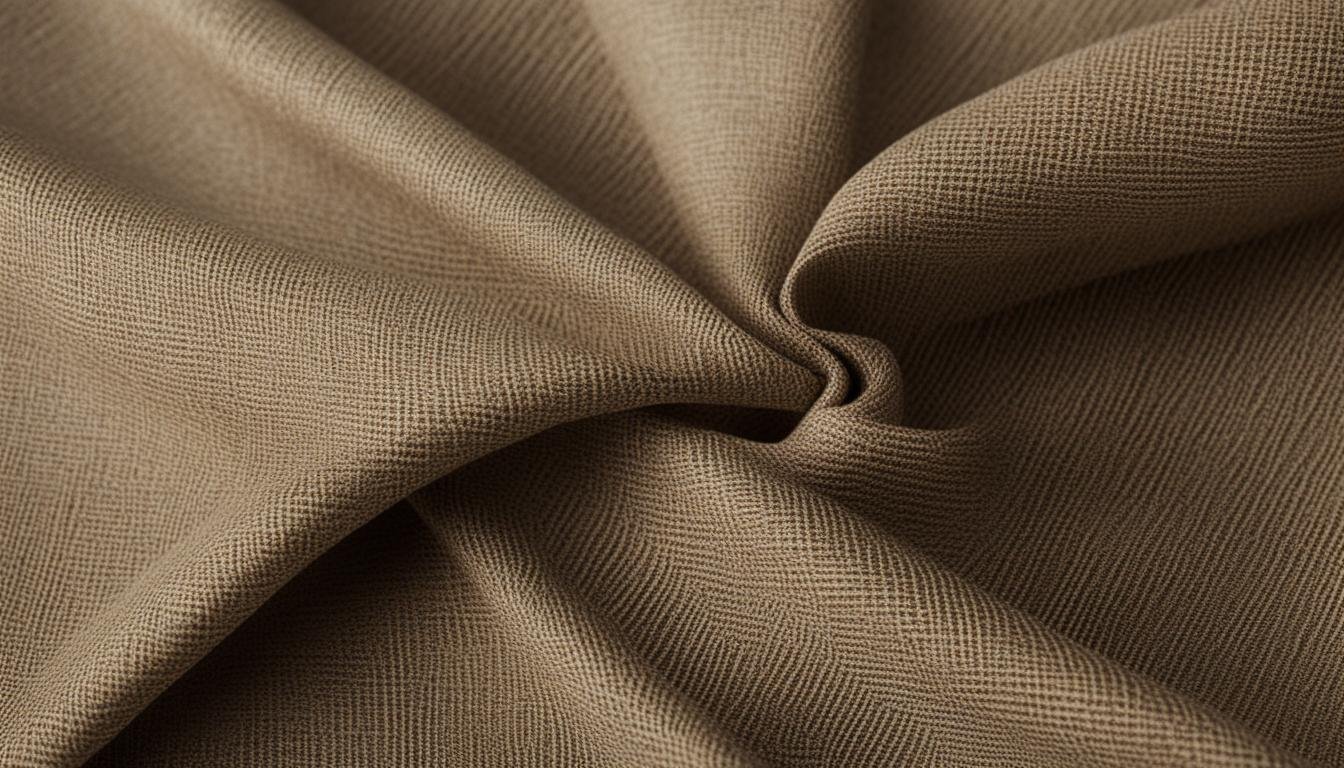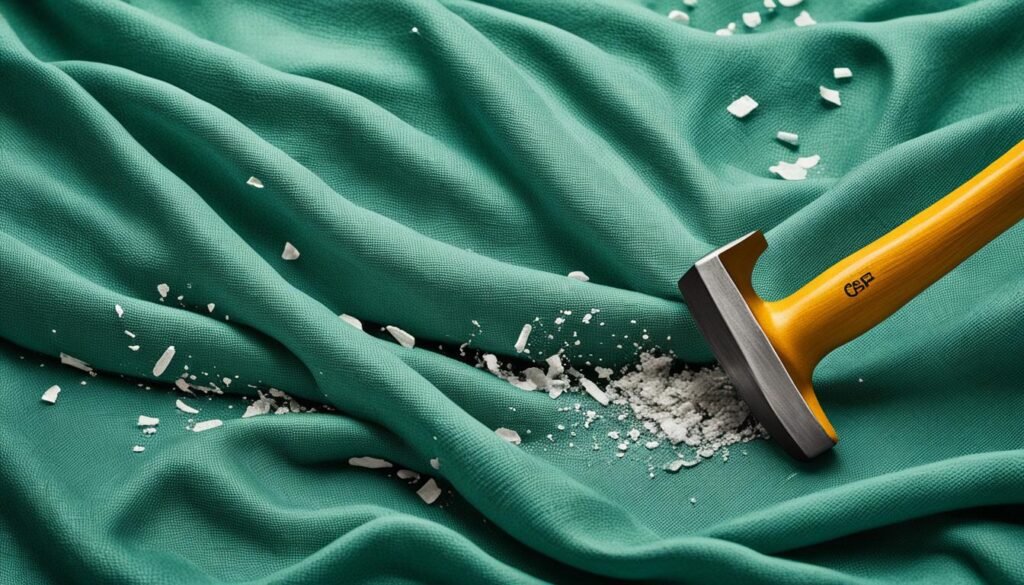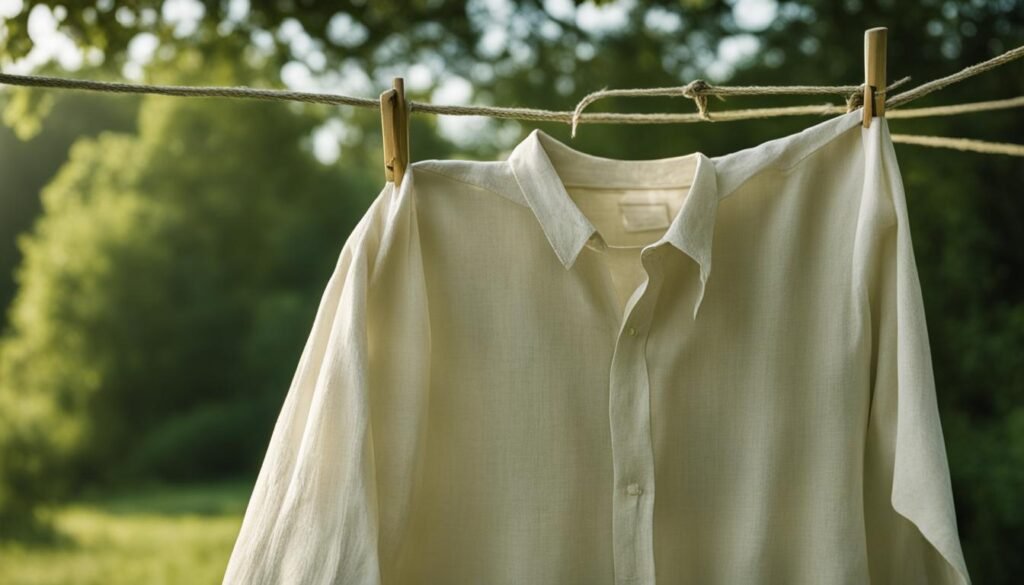Your cart is currently empty!

Busting Common Linen Fabric Care Myths Simplified
The world of home textiles is rife with misconceptions, especially when it comes to the understated elegance of linen. As a fabric that traces back to ancient civilizations, linen has adorned our lives with its durability, comfort, and style. Yet, some consumers are hesitant to embrace this versatile material due to a proliferation of linen fabric myths. It’s time to unravel the threads of fiction and reintroduce fact into the narrative of linen.
Respected industry stalwarts like LinenMe, Natural Product World, and Piglet in Bed have come forward to dispel the fallacies surrounding linen care. Misguided notions of excessive cost, troublesome wrinkles, and complex maintenance have long deterred potential admirers of linen. The truth, however, paints a different picture – one of cost-effectiveness, inherent charm, and ease of care. These revelations are transforming how we view linen care tips, perceptions of home textiles misconceptions, and ultimately, our day-to-day living comfort.
Key Takeaways
- Linen fabric myths often overstate the difficulty and cost of care, leading to unnecessary hesitation among consumers.
- Experts from LinenMe and other industry leaders debunk the misconception of linen as a luxuriously unaffordable material.
- The natural crinkles in linen add to its charm, refuting the myth that its wrinkles signify a lack of sophistication.
- Maintenance for linen is much simpler than widely believed, involving standard machine washing and drying.
- Linen’s ability to hold dye results in a vibrant palette challenging the myth that it comes in plain designs.
- With its temperature-regulating properties, linen is versatile, ideal for use across all seasons, despite common myths.
The Undeniable Durability and Versatility of Linen
The resilience and adaptability of linen are unrivaled, as it consistently debunks the myth regarding its wear. Durable linen textiles, stemming from robust natural fibers, are engineered to endure, challenging the idea that they wear out swiftly. The flax plant, with its substantial, sturdy fibers, imbues the fabric with a toughness that is often up to three times stronger than cotton, ensuring that, with correct care, linen articles remain in prime condition for countless years.
In the realm of versatile linen fabrics, this material stretches far beyond the limits of simple country-style ornamentation or exclusive summer use. Its thermo-regulating properties grant it the flexibility to navigate through the array of interior design trends and an extensive range of climatic conditions. This versatility is further demonstrated in its capacity to retain its vibrancy of color, even post-multiple laundering sessions:
| Color | Pre-Wash | Post-Wash |
|---|---|---|
| Soft Ivory | Brilliant White | Warm Alabaster Glow |
| Vivid Coral | Bright and Bold | Lush Sun-kissed Peach |
| Nautical Blue | Deep Sea Richness | Oceanic Fade Resistant |
| Elegant Charcoal | Sleek Urban Chic | Refined Industrial Sheen |
The table underscores the point; from spirited citrusy shades to composed neutral hues, linen continues to radiate elegance and allure, defying the misconception of its fleeting beauty. Thus, linen stands as an exemplary fabric for various lifestyles, signifying its ability to diversify across assortments of preferences and occasions.
As consumers explore the wide-ranging applications of linen, from buoyant summer attires to cozy wintertime essentials, the revelation of the fabric’s dexterity and lasting durability only grows more pronounced. In this exploration, a profound appreciation for linen’s timeless nature and its instrumental role in crafting versatile, lasting, and stylish textiles takes root.
Common Linen Fabric Care Myths Debunked
In an effort to clarify the truths of linen and its maintenance, we are debunking linen myths so you can embrace the fabric’s innate cost-effectiveness and beauty without hesitation. These scrupulously detailed explanations will guide you through a better understanding, refuting widespread fabric care misconceptions and affirming linen’s cost-effectiveness.

Myth: High Cost Equals High Quality
It is a common belief that high costs are synonymous with high quality, but when it comes to linen, this isn’t always the case. Experts illuminate that the intrinsic value of linen is reflected in its dependable durability and exceptional fabric quality, which can be found at reasonable prices, particularly through online retailers. The notion that an elevated price denotes superior quality is thoroughly debunked in the context of linen.
Myth: Linen Is Inherently Wrinkly and Messy
Linen’s natural crinkles are often mistaken for messy imperfections, but flax enthusiasts understand these creases as a hallmark of the fabric’s effortless allure. While the crinkles are an integral part of linen’s distinctive look, those desiring a crisper aesthetic can simply iron the material for a smooth appearance. This eradicates the myth that linen is perpetually wrinkly and unkempt.
Myth: Extraordinary Measures for Linen Maintenance
The assumption that linen requires high-maintenance care is just another myth waiting to be dispelled. In reality, linen is far from finicky; it is fully machine-washable, and to the delight of many, it grows softer with each wash. This negates the fallacy that extraordinary measures are necessary to keep linen in pristine condition.
Myth: Linen’s Beauty Is Only Skin-Deep and Plain
Linen, far from being one-dimensional, boasts a broad spectrum of vibrant hues and sophisticated patterns that appeal to various tastes. The wide range of available colors and textures challenges the myth of linen’s supposed plainness, revealing a world where the fabric’s beauty perfectly coexists with practical functionality.
Myth: Linen Is Merely a Summer Affair
Many believe that linen is confined to the summer wardrobe, but its benefits extend well beyond the warmer months. Thanks to its insulating properties, linen serves as a comfort-controlling wonder all year round, making it as appropriate for chilly winters as it is for the summer heat. This shatters the stereotype of linen as exclusively a seasonal fabric.
Through a focused scrutiny of each myth, we not only uncover the profound benefits of linen but also recognize its rightful place as a smart investment in long-lasting, adaptable, and gracious living.
The Truth Behind Linen’s Texture and Wearability
Linen’s allure is not solely based on its eco-friendliness or aesthetic value; it’s also deeply rooted in its functional properties. The material’s linen texture attributes, combined with its proven sustainable fabric care, contributes to the remarkable linen wearability that makes it a steadfast choice in both fashion and home décor. Let’s debunk some of the most common misconceptions about linen and reveal the real reasons behind its growing popularity.
Thread Count Misconceptions
It’s a common myth that higher thread counts are indicative of better quality textiles. However, with linen, a high thread count does not equate to higher quality due to the naturally thicker fibers derived from the flax plant. This distinction means that linen can offer a luxurious feel with a lower thread count, which often surprises those accustomed to equating quality with higher numbers.
Linen’s Improving Softness Over Time
Another remarkable facet of linen is its capacity to enhance in softness over time. Contradicting the belief that linen maintains a consistent textural state, it instead evolves, becoming even more comfortable with each wash and wear. This gradual softening enriches the fabric, ensuring it becomes even more enjoyable the longer it’s owned—a testament to the value of investing in high-quality linen goods.
Caring Instructions for Long-lasting Linen
For those dedicated to sustainable fabric care, maintaining linen couldn’t be simpler. Caring instructions to prolong the life of linen include straightforward machine washing, and it can even be tumble dried. Its breathability and moisture-wicking qualities mean fewer washes are needed, ultimately preserving the fabric’s integrity and the planet’s resources.
To illustrate the practical aspects of linen care, let’s consider a comparative analysis:
| Care Aspect | Linen | Other Fabrics |
|---|---|---|
| Washing Frequency | Less Frequent | More Frequent |
| Washing Method | Machine Washable | Varies |
| Drying Method | Tumble Dry or Line Dry | Often Line Dry Only |
| Softness Over Time | Increases | May Decrease |
| Environmental Impact | Reduced Water Usage | Higher Water and Energy |
The data showcases how linen care significantly leads to long-term benefits. Not only does it require less frequent laundering—courtesy of its unique texture—but it also supports an eco-friendlier approach.
The longevity and adaptability of linen, when looked after properly, align smoothly with the growing demand for sustainable fashion and home textiles. By elucidating the truths behind the care and preservation of linen, one can freely invest in this fabric, assured of its lasting wearability and textural charm.

Conclusion
Throughout our exploration of linen — its care, usage, and the myths that shroud it — we’ve unearthed the genuine qualities that make it a modern staple in both fashion and home decor. Dispelling these prevalent misconceptions reaffirms the material’s accessibility and resilience, presenting sustainable linen benefits as a significant consideration for eco-conscious consumers. Embracing myth-free linen care positions this age-old fabric within a contemporary narrative where luxury meets practicality.
Linen’s textile journey is one woven with adaptability and style, leading to an ever-increasing popularity among those who seek out materials that embody quality, sustainability, and comfort. It’s in the commitment to truth and quality assurance that we see linen’s evolution from antiquity to a chic, multifaceted fabric perfectly aligned with the needs of today’s discerning enthusiasts.
With every myth debunked and every truth revealed, consumers are equipped to make informed choices, engaging with a fabric that promises not just enduring beauty but also an endorsement of environmental responsibility. The resurgence of linen’s popularity conveys a community’s collective nod to a future where tradition and innovation are seamlessly interlaced, ensuring that every selection of linen enriches our lives with its timeless charm.
FAQ
Can I afford high-quality linen, or is it too expensive?
High-quality linen is more accessible than many think; it offers exceptional durability and fabric quality often at reasonable prices, particularly when purchased online.
Does linen always have to look wrinkled and messy?
Linen’s natural crinkles contribute to its charm, but for those who prefer a cleaner look, it can be ironed for a smooth finish without tarnishing its character.
Is taking care of linen complicated and time-consuming?
Contrary to this common myth, linen maintenance is straightforward. It’s machine-washable and requires no extraordinary measures, becoming softer with each wash.
Are all linen products plain and lacking in variety?
Linen comes in a wide range of colors and patterns, dispelling the myth that it’s plain. Its versatility is evident in its ability to complement various tastes and interior designs.
Is linen only suitable for summer?
Linen is not just a summer textile; it’s suitable for year-round use thanks to its thermal regulation properties, keeping you cool in summer and warm in winter.
Does a high thread count indicate the best quality linen?
In the case of linen, a high thread count is not essential for quality due to the natural thickness of its fibers. Linen’s luxury comes from the careful sourcing of flax and the weaving process.
Will linen always feel coarse to the touch?
Linen fabric actually becomes increasingly soft over time with each wash and use, countering the myth that it remains perpetually rough.
What are the best practices for caring for linen to ensure it lasts a long time?
Proper linen care involves machine washing according to the care label, potentially tumble drying on low, and understanding its breathable and moisture-wicking qualities to reduce laundering frequency.
Leave a Reply